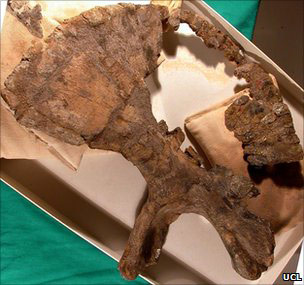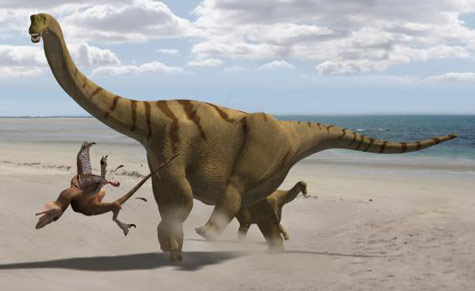Palaeontologists get a “Kick” out of New Sauropod Genus
Brontomerus mcintoshi – The Dinosaur Dubbed “Thunder Thighs”
A team of American and British scientists have named a new genus of Early Cretaceous sauropod from Utah “Thunder Thighs” as they believe that this particular long-necked dinosaur possessed a strong and powerful kick.
Although only fragmentary remains have been found, partially due to the poor state of preservation of the fossils, but also due to the fact that the excavation site had been looted by private collectors, scientists are confident that this new genus of sauropod had very robust, powerful limbs, strong enough to send a predatory dinosaur flying with one swift kick.
Commenting on this large-limbed Sauropod Dr Mike Taylor of the University College London, the lead author on the scientific paper on this creature stated:
“If predators came after it, it would have been able to boot them out of the way.”.
Details regarding this new dinosaur taxon have been published in the scientific journal “Acta Palaeontologica Polonica”, it will no doubt get a lot of publicity due to the genus name resembling the now defunct taxon Brontosaurus and the fact that it had very large thighs. Hopefully, as a result of the publicity, more will be done to help protect scientific sites from looting, as little more can be found out about this dinosaur due to the limited fossil material recovered. The name of this new taxon literally means “thunder thighs”, but just why this dinosaur had such strong legs remains open to speculation.
The Ilium (Hip-Bone) of B. mcintoshi

Picture credit: University College London
The ilium bone of this dinosaur has a forward projecting blade, proportionally much bigger than in similarly sized sauropods. This suggests that large thigh muscles were anchored there.
The fossils of two specimens an adult; estimated to measure around 14 metres in length and to weigh perhaps as much as six tonnes and a pony-sized juvenile were found in close proximity. The American and British researchers have speculated that the youngster could be the offspring of the adult, although there is little firm evidence to prove this.
However, sauropod tracks discovered last year seem to show young animals following an adult, perhaps these huge animals did protect their offspring by staying close to them, at least until the babies were big enough to look after themselves.
To read more about the sauropod trackways: Running with Baby Sauropods.
The fossils have been dated to around 110 million years ago (Albian faunal stage of the Cretaceous), a time when fast running packs of dromaeosaurs roamed the open plains. Perhaps, this dinosaur evolved strong legs in order to kick out at and fend off attacks of predatory dinosaurs such as Deinonychus and Utahraptor.
The site, part of a quarry had been looted by commercial fossil-hunters but despite this enough fossil material was located in order to provide an analysis and the information required to identify a new taxon.
Brontomerus mcintoshi
The evidence for the large leg muscles comes from the ilium (part of the hips). It is unusually large in comparison with other similar sized dauropods and the wide blade of the ilium projects forward providing a large area for the anchoring of leg muscles (femoral protraction and abductor muscles), muscles which would have helped to move the leg out and away from the body. No actual leg bones have been recovered so at this time the reason for the big thigh muscles remains unknown, however, this dinosaur would have been capable of delivering a powerful kick, easily strong enough to send a hungry dromaeosaur flying.
Dr Taylor added:
“As you put the skeleton together, you can run muscles down from the hip-bone to join at the knee and that gives you a whopping thigh. What’s interesting is that if it were a sauropod that could move particularly fast, you would expect to see very strong muscles on the back of the legs to pull it along [retractor muscles], but we don’t.
A Restoration of B. mcintoshi

Picture credit: F. Gascó.
In the picture, a mother Brontomerus is defending a juvenile by kicking out at an attacking dromaeosaur.
In addition to the unusual ilium, the shoulder blade (scapula) has strange bumps on it that probably mark the boundaries of muscle attachments, indicating that this dinosaur also had powerful forelimb as well.
Co-author of the study Dr Matt Wedel, from the Western University of Health Sciences in Pomona, California stated:
“It’s possible that Brontomerus mcintoshi was more athletic than most other Sauropods. It is well established that far from being swamp-bound hippo-like animals, Sauropods preferred drier, upland areas; so perhaps Brontomerus lived in rough, hilly terrain and the powerful leg muscles were a sort of ‘dinosaur four-wheel drive’.”
This discovery, plus numerous other sauropod finds dating from Lower Cretaceous strata is helping to change palaeontologist’s perception about the diversity of the Sauropoda during the Early Cretaceous. It had been thought that the lizard-hipped sauropods had been largely replaced by herbivorous ornithischian dinosaurs in the food chains of the Northern Hemisphere by around 100 million years ago. As more sauropod fossils are discovered it seems that scientists may have to revise the views held regarding the diversity and abundance of long-necked dinosaurs.
Dr Wedel commented:
“In the past twenty years, however, we are finding more sauropods from the Early Cretaceous period, and the picture is changing. It now seems that sauropods may have been every bit as diverse as they were during the Jurassic, but much less abundant and so much less likely to be found.”
The fossilised bones of the two dinosaur specimens are currently at the Sam Noble Museum of Natural History in Norman (Oklahoma). Plans are at an early stage to re-visit the location to see if more fossil material relating to this new genus can be discovered. If elements of the leg bones could be found then this may help solve the mystery of the dinosaur with the “thighs like a body builder”. With more fossils to study, the team could perhaps provide a more accurate assessment of the phylogeny of this sauropod, at the moment it has been tentatively ascribed to the camarasaurids.
It is possible, that this dinosaur may have resembled a giraffe and the strong hind limbs could have played a role in supporting the animal’s weight as it rocked back onto its back legs so that it could crane its neck higher to reach the branches of trees that other dinosaurs could not reach.
In antelopes there are many members of this family who have adapted a basic body plan to help them feed on vegetation that other animals cannot. The long-limbed, long-necked Gerenuk (Litocrannius walleri) of southern Africa has exceptionally strong thighs that enable it to rear up on its hind legs to feed on the branches of thorn bushes that other antelopes can’t reach – could the large thigh muscles of B. mcintoshi have helped this dinosaur to do something similar?
For models and replicas of sauropod dinosaurs: Mojo Fun Prehistoric and Extinct Figures.

